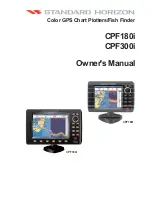
Glossary
Sonar
Power Output
The amount of sound energy emitted into the water by the transducer’s transmitter. Power
output is measured using either RMS (Root Mean Square) or P-T-P (Peak-to-Peak) measurement systems.
Either method is acceptable, but it is important when comparing power outputs, to make sure that the same
measurement system is being used for both outputs, because P-T-P numbers are 8 times higher than RMS
numbers. Greater power output allows the sonar signal to penetrate through weeds and thermoclines, reach
deeper depths and operate more effectively in noisy environments, such as when the boat is running at high
speed.
Pulse Width (Pulse Length)
The length of time that a sonar sound burst is transmitted into the water.
Shorter pulse widths provide better target separation, but cannot travel to great depths. Longer pulse widths
provide better depth penetration, but result in poorer target separation. Humminbird® varies pulse width
based on depth to optimize both target separation and depth performance. See
Target Separation
.
Second Return
Describes the appearance of a second sonar return below the primary sonar return (bottom
contour) at exactly twice the true depth. The second return is caused by the same sonar energy bouncing
off the bottom once, rebounding to the water surface and then traveling back down to the bottom to be
reflected again. Second returns are more common in shallow water and over hard bottoms; it is possible to
see a third sonar return under some circumstances. The second return provides useful information to help
determine bottom hardness, as areas with harder bottoms will generally create a second return. The second
return can be used as a guide to set Sensitivity when in shallower water.
SONAR (SOund and NAvigation Ranging)
Sonar technology uses precision sound bursts transmitted
underwater to determine the distance and other attributes of objects in the water. Distance can be determined
because the speed of sound in water is constant, and the time for the signal to return is measured. Sound also
travels very quickly underwater, making sonar a responsive, cost-effective tool. Sonar is the basic technology
behind all recreational and commercial fishfinding and depthfinding devices.
Sonar Update Rate
The number of times per second that the transducer’s transmitter/receiver sends and
receives sonar signals. A very fast sonar update rate collects more information and provides a more detailed
image of the bottom, fish, and structure. Many Humminbird® units operate at up to 40 times per second
when in single frequency operation. Due to the limitation of the speed of sound in water, the update rate
begins to slow as depth increases to deeper than 50 feet. In very shallow water (less than 10 feet), however,
update rates as much as 60 times per second can be achieved.
Speed
The rate at which the boat moves through the water. Boat speed can be measured as Speed Over
Ground or Speed Through Water. Speed Over Ground is provided by GPS, and is the measurement of the
boats progress across a given distance. Speed Through Water is provided by a speed paddlewheel, and is
the measurement of the flow past the boat, which may vary depending on current speed and direction.
Speed Through Water is most critical for anglers using downriggers, as it impacts the running depth of the
down riggers. Speed Over Ground is optimal for navigation, as accurate destination times can be derived
from this measurement. Humminbird® products allow for input and display of both sources.
Structure
A general term for objects on the bottom that present a discontinuity and are a likely attractor
for fish. This includes bottom contour features (drop-offs, humps, and holes), standing structure (stumps,
timbers, brush piles), and a wide range of other potential objects (sunken boats, reefs).
Surface Clutter
A phenomenon where sonar returns are reflected off of tiny objects near the surface of
the water, including algae and even air bubbles. Typically, saltwater environments have significantly greater
surface clutter than freshwater due to continuous wind and wave action that causes aeration at the surface.
Glossary - Sonar
214
Summary of Contents for 1158c Combo
Page 1: ...Installation and Operations Manual 1158c Combo 1198c SI Combo Product Manual...
Page 73: ...61 to your boat including the following items What s on the Sonar Display 7 10 3 4 5 6 11...
Page 146: ...Sonar Tab Normal Mode Sonar Tab Advanced Mode Menu Quick Tips 134...























